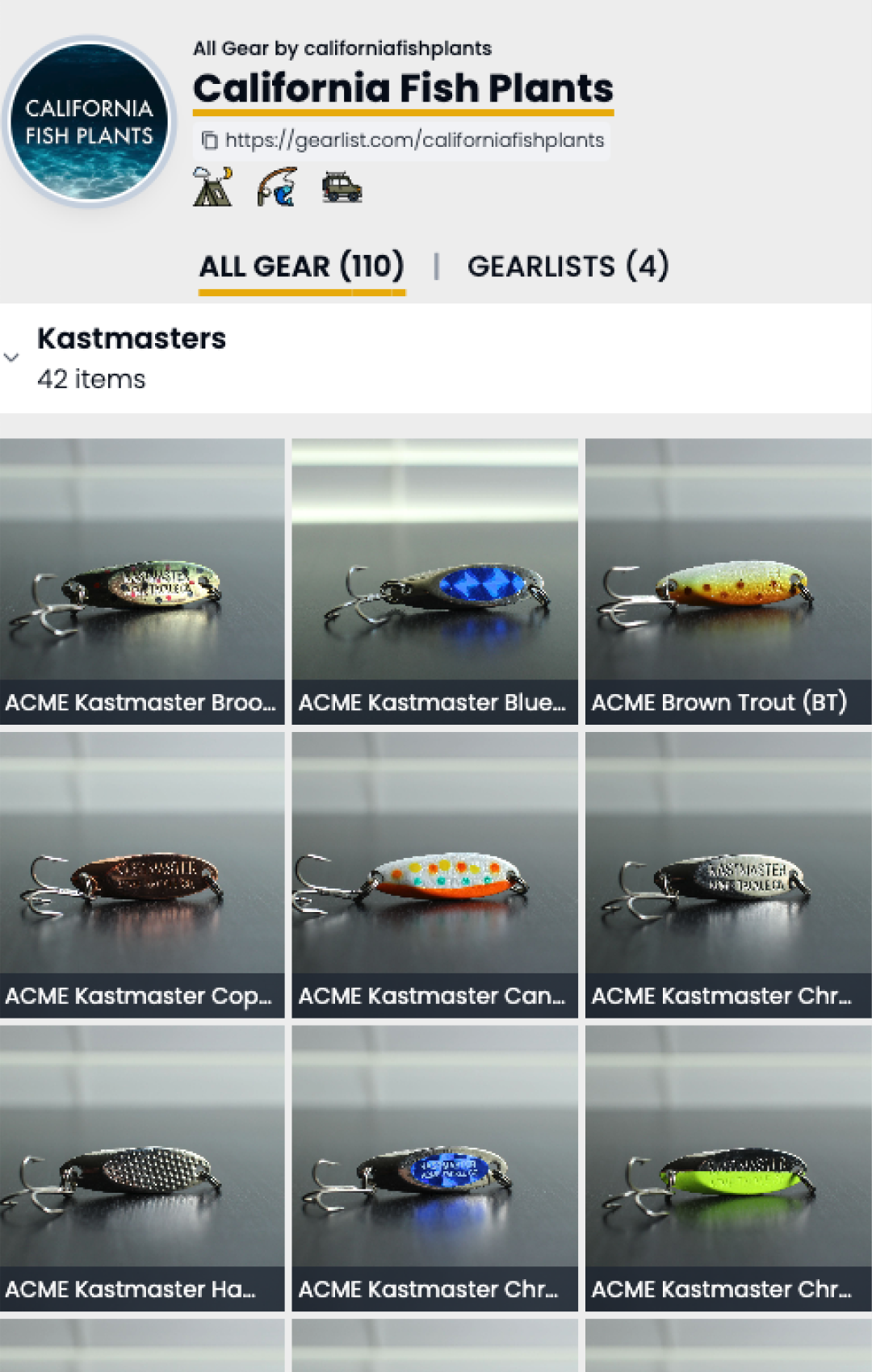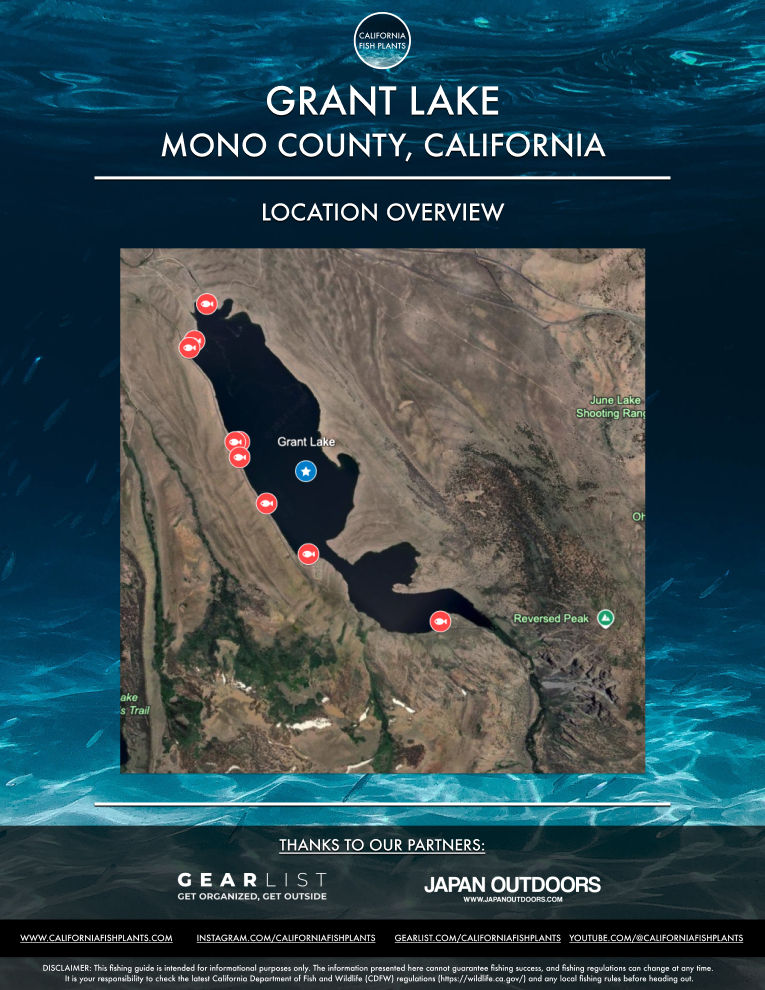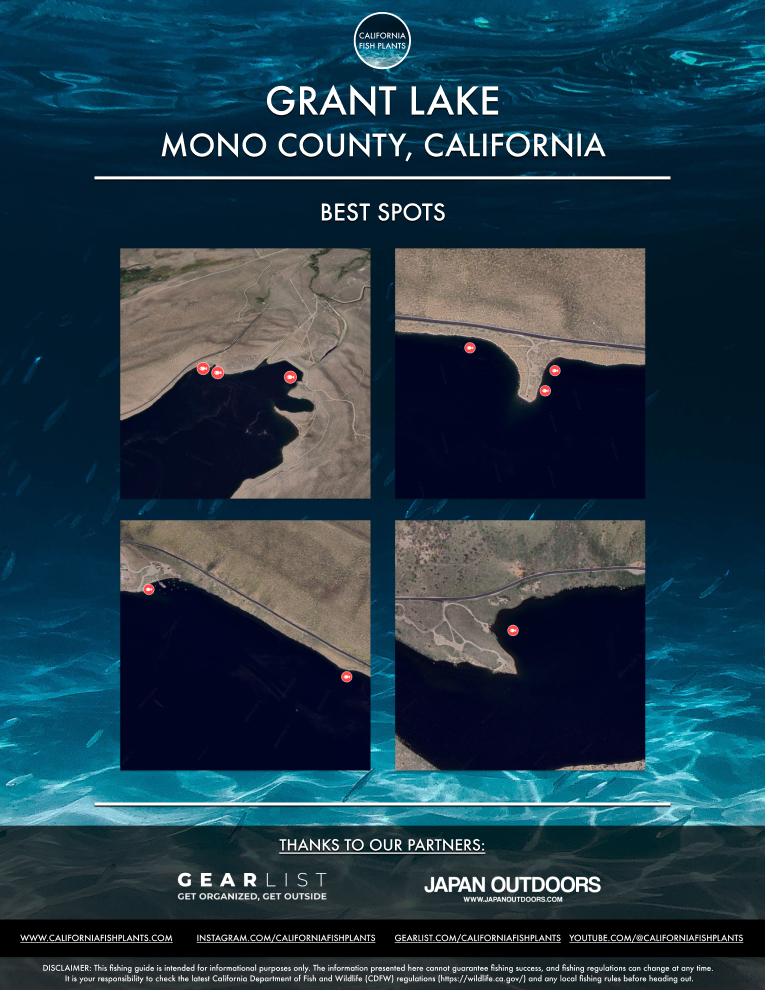Grant Lake, nestled within the majestic June Lake Loop east of Yosemite and Mammoth Lakes, stands not just as a picturesque landscape but as a secluded sanctuary for anglers seeking the thrill of a trophy catch, particularly the elusive German brown trout. Delve into the angler’s guide to Grant Lake, exploring the types of fish awaiting your line, mastering the art of first-time fishing in its waters, and discovering the optimal gear to maximize your chances of success.
📈 Latest Fish Plants
Fish here often?
How To Read Fish Plant Graphs
To interpret fish plant graphs effectively, consider the following key elements:
- Blue Vertical Bars and Numbers:
- Representation: The blue vertical bars on the graph represent individual fish plants.
- Weight Measurement: The associated numbers indicate the total weight of the plants in pounds (lbs.) that occurred during a specific week.
- Significance: Monitoring these bars helps identify weeks with higher planting activity, aiding anglers in selecting optimal times for fishing near recent plantings.
- Orange Trend Line:
- Purpose: The orange trend line represents the moving average of all fish plant activities at the specified location.
- Indicator of Activity: A rising trend line suggests a consistent increase in planting activity over the designated period. This indicates the potential for more catch opportunities and signifies a growing fish population over the weeks.
- Interpreting the Moving Average:
- Upward Trend: A rising moving average implies an upward trajectory in planting activity, indicating an increasing number of fish being introduced into the area. This suggests a positive outlook for anglers, as it implies a larger and potentially more accessible fish population.
- Downward Trend (Not Specified): The description does not provide information on the interpretation of a decreasing trend in the moving average. It might be beneficial to include information on what a decreasing trend could signify in terms of fishing prospects.
- No Data Present:
- Possible Explanations: If no data is visible on the graph, it may indicate that the location had no fish plants in the last three months. Alternatively, the absence of data could be due to non-disclosure of fish plants for that location.
- Natural Population: Some fishing areas in California rely on the natural growth of fish populations, and graphs may not show plants if this is the case.
- Graph Disclaimer:
- Data Source: The graphs reflect a combination of publicly disclosed data and estimates. Some locations may disclose fish plants without specifying exact amounts.
- Not Universal: Not all fishing areas have fish plants, and the natural growth of fish populations plays a significant role in many California fishing locations.
Understanding these elements will empower anglers to make informed decisions about when and where to fish based on historical fish plant data.
Note: If no data is present in the graph above, this location may not have had any plants the last 3 months, or may not have publicly disclosed plants. Graphs reflect both publicly disclosed data and estimates, as some locations disclose plants, but not exact amount.
🗺️ Map & Fishing Location
New to California Fish Plants & Need an Access Code?
Types of Fish You Can Expect to Catch Here:
- German Brown Trout: The monarchs of Grant Lake, known for their strength and size. Target them near drop-offs, submerged logs, and weed beds, using streamers, nymphs, or bait fishing for a chance at a trophy catch.
- Rainbow Trout: Acrobatic fighters that add variety to your fishing experience. Look for them near inlets, shallow areas, and structures like rocks and trees. Lures, spoons, or smaller nymphs can be effective.
- Mackinaw (Lake Trout): Elusive giants lurking in the depths. Troll large lures or deep crankbaits near the dam or in the center of the lake for an exhilarating battle.
Local Insights:
Gain valuable insights for a successful fishing venture in Grant Lake:
- Boat or No Boat?: While shore fishing is possible, a boat, especially a pontoon or kayak, unlocks the true potential of the lake. Explore hidden coves and deeper areas where the big browns prefer to roam.
- Sunrise or Bust: Early mornings are prime time for German browns, especially during hatches. Being on the water before sunrise enhances your chances of a successful catch.
- Respect the Power: German browns are robust and can easily break your line. Use heavy-duty tackle, secure knots, and be prepared for a challenging fight.
- Leave No Trace: Grant Lake is a pristine ecosystem. Adhere to principles of responsible fishing, pack out all your trash, practice catch-and-release, and follow wildlife regulations.
Unique Twists:
Explore the distinctive features that make Grant Lake a unique fishing destination:
- Family-Friendly Fun: While challenging for beginners, Grant Lake offers shallows and smaller fish suitable for family outings. Create lasting memories while enjoying the fishing experience together.
- Scenic Backdrop: The June Lake Loop provides stunning vistas of snow-capped peaks, meadows, and forests. Capture the beauty while casting your line and relish the tranquility of the mountains.
- History Whispers: Discover remnants of the past, such as the historic buildings at Grant Lake Marina and nearby mining ruins. Imagine the stories embedded in these stones.
Prime Locations:
Identify the key areas to cast your line and increase your chances of success:
- Dam Area: Cast near the dam for a chance at trophy browns cruising for food. Troll streamers or jig for lurking Mackinaw in the depths.
- Rocky Points: These areas provide structure and ambush points for both browns and rainbows. Cast jigs, crankbaits, or spinners along the shoreline or troll along the drop-offs.
- Weed Beds: Shallows with weed beds are not to be underestimated. Browns use weeds for cover. Try weedless lures, frogs, or small nymphs for surprising catches.
- Hidden Coves: Accessible only by boat, these secluded gems offer solitude and a chance at trophy trout. Explore and find your secret fishing hole.
- Inlets: The mouths of inlets are hotspots for feeding fish. Try bait fishing with nightcrawlers or PowerBait, particularly for rainbows and smaller browns.
Remember, Grant Lake is more than just a fishing hole; it’s a portal to a wild haven, a chance to connect with the rhythm of nature, and maybe catch a fish that will be the envy of all your angler friends. So grab your rod, breathe in the crisp mountain air, and reel in the memories (and hopefully a monster brown) from this hidden gem. Tight lines!





